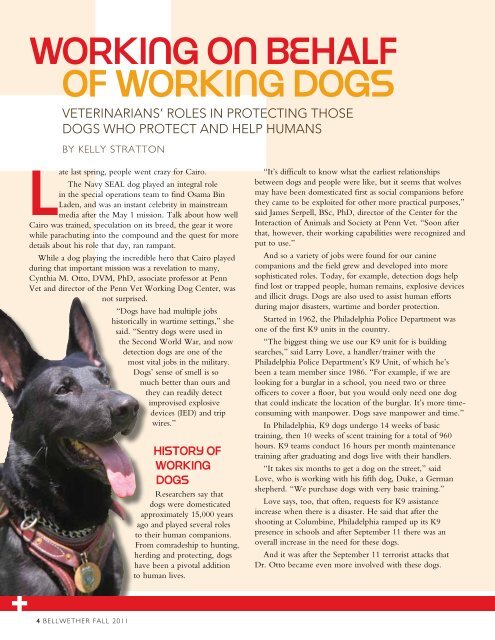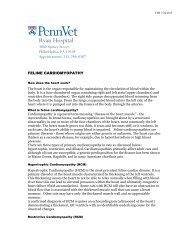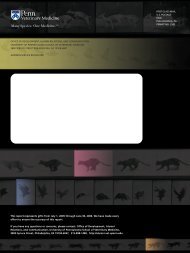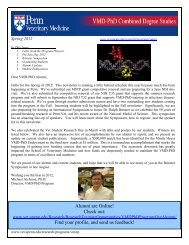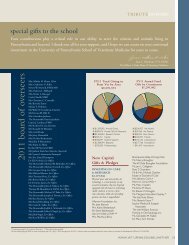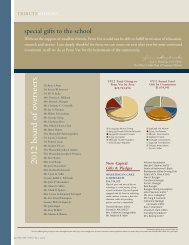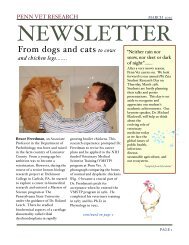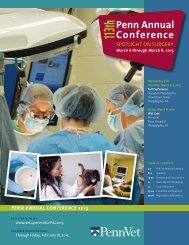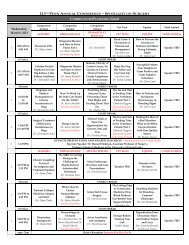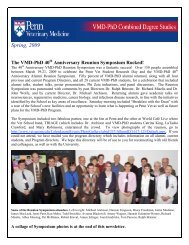You also want an ePaper? Increase the reach of your titles
YUMPU automatically turns print PDFs into web optimized ePapers that Google loves.
<str<strong>on</strong>g>Working</str<strong>on</strong>g> <strong>on</strong> <strong>Behalf</strong><br />
<strong>of</strong> <str<strong>on</strong>g>Working</str<strong>on</strong>g> <strong>Dogs</strong><br />
Veterinarians’ roles in protecting those<br />
dogs who protect and help humans<br />
by Kelly Stratt<strong>on</strong><br />
late last spring, people went crazy for Cairo.<br />
The Navy SEAL dog played an integral role<br />
in the special operati<strong>on</strong>s team to find Osama Bin<br />
Laden, and was an instant celebrity in mainstream<br />
media after the May 1 missi<strong>on</strong>. Talk about how well<br />
Cairo was trained, speculati<strong>on</strong> <strong>on</strong> its breed, the gear it wore<br />
while parachuting into the compound and the quest for more<br />
details about his role that day, ran rampant.<br />
While a dog playing the incredible hero that Cairo played<br />
during that important missi<strong>on</strong> was a revelati<strong>on</strong> to many,<br />
Cynthia M. Otto, DVM, PhD, associate pr<strong>of</strong>essor at Penn<br />
Vet and director <strong>of</strong> the Penn Vet <str<strong>on</strong>g>Working</str<strong>on</strong>g> Dog Center, was<br />
not surprised.<br />
“<strong>Dogs</strong> have had multiple jobs<br />
historically in wartime settings,” she<br />
said. “Sentry dogs were used in<br />
the Sec<strong>on</strong>d World War, and now<br />
detecti<strong>on</strong> dogs are <strong>on</strong>e <strong>of</strong> the<br />
most vital jobs in the military.<br />
<strong>Dogs</strong>’ sense <strong>of</strong> smell is so<br />
much better than ours and<br />
they can readily detect<br />
improvised explosive<br />
devices (IED) and trip<br />
wires.”<br />
4 bellwether Fall 2011<br />
History <strong>of</strong><br />
<str<strong>on</strong>g>Working</str<strong>on</strong>g><br />
<strong>Dogs</strong><br />
Researchers say that<br />
dogs were domesticated<br />
approximately 15,000 years<br />
ago and played several roles<br />
to their human compani<strong>on</strong>s.<br />
From comradeship to hunting,<br />
herding and protecting, dogs<br />
have been a pivotal additi<strong>on</strong><br />
to human lives.<br />
“It’s difficult to know what the earliest relati<strong>on</strong>ships<br />
between dogs and people were like, but it seems that wolves<br />
may have been domesticated first as social compani<strong>on</strong>s before<br />
they came to be exploited for other more practical purposes,”<br />
said James Serpell, BSc, PhD, director <strong>of</strong> the Center for the<br />
Interacti<strong>on</strong> <strong>of</strong> Animals and Society at Penn Vet. “So<strong>on</strong> after<br />
that, however, their working capabilities were recognized and<br />
put to use.”<br />
And so a variety <strong>of</strong> jobs were found for our canine<br />
compani<strong>on</strong>s and the field grew and developed into more<br />
sophisticated roles. Today, for example, detecti<strong>on</strong> dogs help<br />
find lost or trapped people, human remains, explosive devices<br />
and illicit drugs. <strong>Dogs</strong> are also used to assist human efforts<br />
during major disasters, wartime and border protecti<strong>on</strong>.<br />
Started in 1962, the Philadelphia Police Department was<br />
<strong>on</strong>e <strong>of</strong> the first K9 units in the country.<br />
“The biggest thing we use our K9 unit for is building<br />
searches,” said Larry Love, a handler/trainer with the<br />
Philadelphia Police Department’s K9 Unit, <strong>of</strong> which he’s<br />
been a team member since 1986. “For example, if we are<br />
looking for a burglar in a school, you need two or three<br />
<strong>of</strong>ficers to cover a floor, but you would <strong>on</strong>ly need <strong>on</strong>e dog<br />
that could indicate the locati<strong>on</strong> <strong>of</strong> the burglar. It’s more timec<strong>on</strong>suming<br />
with manpower. <strong>Dogs</strong> save manpower and time.”<br />
In Philadelphia, K9 dogs undergo 14 weeks <strong>of</strong> basic<br />
training, then 10 weeks <strong>of</strong> scent training for a total <strong>of</strong> 960<br />
hours. K9 teams c<strong>on</strong>duct 16 hours per m<strong>on</strong>th maintenance<br />
training after graduating and dogs live with their handlers.<br />
“It takes six m<strong>on</strong>ths to get a dog <strong>on</strong> the street,” said<br />
Love, who is working with his fifth dog, Duke, a German<br />
shepherd. “We purchase dogs with very basic training.”<br />
Love says, too, that <strong>of</strong>ten, requests for K9 assistance<br />
increase when there is a disaster. He said that after the<br />
shooting at Columbine, Philadelphia ramped up its K9<br />
presence in schools and after September 11 there was an<br />
overall increase in the need for these dogs.<br />
And it was after the September 11 terrorist attacks that<br />
Dr. Otto became even more involved with these dogs.
ensuring the Health<br />
<strong>of</strong> Canine Helpers<br />
Golden retriever bretagne worked with handler denise<br />
Corliss as a resp<strong>on</strong>der to the September 11 disaster.<br />
M<strong>on</strong>itoring Resp<strong>on</strong>ders’ Health<br />
As an <strong>on</strong>-the-ground resp<strong>on</strong>der to work with the search and<br />
rescue dogs who served at Ground Zero, Dr. Otto launched a<br />
l<strong>on</strong>gitudinal study, still <strong>on</strong>going and funded by the American<br />
Kennel Club’s Compani<strong>on</strong> Animal Recovery (AKC CAR),<br />
whereby she would follow the resp<strong>on</strong>ding dogs and m<strong>on</strong>itor<br />
any <strong>of</strong> their health problems. Out <strong>of</strong> the 300 dogs that<br />
resp<strong>on</strong>ded, about 25 percent are still living.<br />
“In the 9/11 study so far, we didn’t see major impact <strong>on</strong><br />
the respiratory system, but dogs d<strong>on</strong>’t get asthma so they<br />
aren’t a good model for that,” said Dr. Otto. “They have a<br />
better filtering system in their noses than people so maybe<br />
that’s why their respiratory system wasn’t affected.”<br />
There was, however, a trend in the heart.<br />
“There is X-ray and some post-mortem evidence that<br />
there is a change in the heart in these dogs who serve,” said<br />
Dr. Otto. “The polluti<strong>on</strong> may have c<strong>on</strong>tributed in those<br />
changes rather than in respiratory changes. Understanding<br />
these changes may also be important for people.”<br />
Finding a DNA Fingerprint<br />
Another <strong>of</strong> Dr. Otto’s projects involves building a DNA<br />
Bank and Health Registry database, which may shed some<br />
light <strong>on</strong> a dog’s capacity to work. So far, the Bank houses<br />
more than 300 samples. It’s work that the AKC CAR has<br />
supported.<br />
The idea is that if a genetic fingerprint is found in these<br />
working dogs, informati<strong>on</strong> can be applied to help search and<br />
rescue organizati<strong>on</strong>s, law enforcement, breeders and handlers<br />
to identify factors c<strong>on</strong>tributing to the success <strong>of</strong> these vital<br />
dogs.<br />
“If we know the DNA fingerprint we may be able to look<br />
at shelter dogs to pull to work, too,” said Dr. Otto.<br />
Because approximately <strong>on</strong>ly 30 percent <strong>of</strong> dogs entering<br />
detecti<strong>on</strong>-training programs are successful, this is important<br />
informati<strong>on</strong> that can be used to assist in breeding selecti<strong>on</strong><br />
and the creati<strong>on</strong> <strong>of</strong> more successful working canines.<br />
Data collected includes blood samples for DNA and<br />
serum banking for dogs trained to detect live humans,<br />
cadavers, explosives or drugs; pedigrees/blood lines; training<br />
informati<strong>on</strong>; behavioral assessments; health assessments;<br />
training certificati<strong>on</strong>s and updates. Dr. Otto will use this data<br />
to perform genotyping <strong>of</strong> markers throughout the canine<br />
genome to detect linkages between health and working traits<br />
and specific regi<strong>on</strong>s <strong>of</strong> the genome.<br />
In additi<strong>on</strong> to her studies, Dr. Otto also started a semiannual<br />
c<strong>on</strong>ference for working dog handlers. This year’s<br />
c<strong>on</strong>ference “Defining, Developing and Documenting Success<br />
in <str<strong>on</strong>g>Working</str<strong>on</strong>g> <strong>Dogs</strong>,” took place in Pearl River, New York<br />
and featured experts from around the world who discussed<br />
puppy selecti<strong>on</strong> and development; performance testing and<br />
certificati<strong>on</strong>; and physical c<strong>on</strong>diti<strong>on</strong>ing <strong>of</strong> working dogs.<br />
“Our missi<strong>on</strong> is to share the knowledge available to<br />
improve the health, breeding and performance <strong>of</strong> working<br />
dogs,” said Dr. Otto. “The US gets most <strong>of</strong> its dogs from<br />
Eastern Europe and <strong>of</strong>ten, they aren’t the best <strong>of</strong> the best,”<br />
said Dr. Otto. “They’re good – really good – but we d<strong>on</strong>’t<br />
know how they are being bred and trained. This work will<br />
help us know which dogs to invest in and allow us to be<br />
self-sufficient in supplying domestically produced dogs as<br />
they’re needed.”<br />
Taking Early Retirement<br />
In some instances, working dogs are retiring themselves early.<br />
These dogs, guide and service dogs, have jobs that assist the<br />
blind or physically handicapped and most are either German<br />
shepherd dogs, Labrador retrievers, golden retrievers or LR<br />
x GR crosses. According to Dr. Serpell, studies have shown<br />
that up to 20 percent <strong>of</strong> these kinds <strong>of</strong> guide dogs give up<br />
their work after <strong>on</strong>ly a short period <strong>of</strong> time.<br />
“One to three years into the job, they seem to give up,”<br />
said Dr. Serpell. “It’s not clear to these organizati<strong>on</strong>s why that<br />
is. We want to predict why it is happening because training<br />
these dogs is expensive and time-c<strong>on</strong>suming.”<br />
c<strong>on</strong>tinued <strong>on</strong> page 7<br />
www.vet.upenn.edu/bellwether 5
Putting a Plan in Place<br />
dr. lisa Murphy’s expertise is called <strong>on</strong> to help<br />
animals while protecting people in Japan<br />
by Sally SIlverMan<br />
<strong>on</strong> april 29, six weeks after the Fukushima<br />
daiichi nuclear power plant began<br />
leaking radiati<strong>on</strong> following the devastating<br />
earthquake and tsunami in Japan, lisa Murphy,<br />
vMd traveled to the country to assist in<br />
relief efforts.<br />
dr. Murphy, an assistant pr<strong>of</strong>essor at penn<br />
vet, was part <strong>of</strong> a team dispatched by the<br />
Internati<strong>on</strong>al Fund for animal welfare (IFaw)<br />
at the invitati<strong>on</strong> <strong>of</strong> the Fukushima prefecture department <strong>of</strong> the<br />
envir<strong>on</strong>ment. the goal was to assist rescue groups, veterinary<br />
associati<strong>on</strong>s and government agencies to determine the best way to<br />
cope with animals affected. part <strong>of</strong> the group addressed agricultural<br />
livestock, another subgroup dealt with wildlife and dr. Murphy’s team<br />
focused <strong>on</strong> compani<strong>on</strong> animals.<br />
while the Japanese are devoted to their pets, and compani<strong>on</strong><br />
animals are living in homes in increasing numbers, there was no<br />
plan for their care when disaster struck. In additi<strong>on</strong>, there was little<br />
understanding <strong>of</strong> the effects <strong>of</strong> radiati<strong>on</strong>. while displaced residents<br />
l<strong>on</strong>ged to be reunited with their pets, c<strong>on</strong>cerns about whether<br />
the animals were c<strong>on</strong>taminated, and how that could impact their<br />
owners, were very real.<br />
Planning for Disaster<br />
dr. Murphy was involved in the care <strong>of</strong> animals after hurricane<br />
Katrina, as well as in the medical treatment <strong>of</strong> search and rescue<br />
dogs following 9/11. Since 1993 she has been a member <strong>of</strong> the<br />
american veterinary Medical associati<strong>on</strong>’s (avMa) veterinary<br />
Medical assistance team (vMat).<br />
“during a disaster or emergency we can be called up<strong>on</strong> to do<br />
pretty much anything a veterinarian’s qualified to do and that’s how<br />
we’ve been trained,” said dr. Murphy.<br />
It’s that training that made dr. Murphy a go-to expert to resp<strong>on</strong>d to<br />
the disaster in Japan.<br />
research has shown that up to 30 percent <strong>of</strong> evacuees attempt to<br />
re-enter a disaster z<strong>on</strong>e to rescue pets. It was known that rogue<br />
rescue groups in Japan were entering restricted z<strong>on</strong>es without<br />
protecti<strong>on</strong>, exposing themselves and others to chemical, biological<br />
and radioactive c<strong>on</strong>taminants. this was a human health and safety<br />
issue as well as an animal welfare issue.<br />
“you can’t see radiati<strong>on</strong>, or smell it or taste it,” said dr. Murphy.<br />
“with people, you can remove 90 percent <strong>of</strong> external radioactive<br />
c<strong>on</strong>taminati<strong>on</strong> by removing clothing. you can’t do that with dogs and<br />
cats.”<br />
dr. Murphy co-chairs the nati<strong>on</strong>al alliance <strong>of</strong> State animal and<br />
agricultural emergency programs (naSaaep) best practices<br />
working group resp<strong>on</strong>sible for developing guidelines for animal<br />
dec<strong>on</strong>taminati<strong>on</strong>. deciding <strong>on</strong> the team to travel to Japan, dick<br />
6 bellwether Fall 2011<br />
Green, edd, emergency relief<br />
manager-disasters for IFaw,<br />
said that radiati<strong>on</strong> expertise<br />
was key.<br />
“In most <strong>of</strong> our resp<strong>on</strong>ses,”<br />
he explained, “we d<strong>on</strong>’t have<br />
a vet with us but have access<br />
to a veterinarian, back at the<br />
receiving end, who can triage<br />
an animal.”<br />
he emphasizes the<br />
importance <strong>of</strong> having<br />
a planning committee<br />
comprised <strong>of</strong> people<br />
with the knowledge and<br />
experience <strong>on</strong> the impact<br />
<strong>of</strong> radiati<strong>on</strong> <strong>on</strong> humans and<br />
animals.<br />
“this is huge from an animal<br />
welfare standpoint,” said<br />
Green, “and huge as far as<br />
the potential impact <strong>on</strong> all<br />
species.”<br />
above images courtesy <strong>of</strong> IFaw<br />
Creating guiDelines for<br />
the JaPanese government<br />
dr. Murphy and her team made recommendati<strong>on</strong>s for the rescue,<br />
dec<strong>on</strong>taminati<strong>on</strong>, transport and housing <strong>of</strong> pets with the goal<br />
to keep people and animals together. the initial evaluati<strong>on</strong> and<br />
dec<strong>on</strong>taminati<strong>on</strong> process would be c<strong>on</strong>ducted in the warm<br />
z<strong>on</strong>e, the regi<strong>on</strong> where animals were exposed to radiati<strong>on</strong>, but at<br />
potentially tolerable levels, by teams with proper pers<strong>on</strong>al protective<br />
equipment. the area would also serve as a sheltering locati<strong>on</strong>.<br />
a cut<strong>of</strong>f <strong>of</strong> 100,000 counts per minute, a measurement <strong>of</strong> radiati<strong>on</strong><br />
determined by a Geiger-counter-like instrument, was set for<br />
livestock. For pets, the cut<strong>of</strong>f was 10,000 counts per minute as an<br />
added margin <strong>of</strong> safety. If an animal, after two baths, still registered<br />
higher, it was likely internally c<strong>on</strong>taminated by self-grooming or by<br />
eating or drinking c<strong>on</strong>taminated food or water. these animals were<br />
at risk for systemic damage, and could spread radiati<strong>on</strong> through<br />
feces and urine; they were reevaluated <strong>on</strong> a 10-day cycle.<br />
as a result <strong>of</strong> the summit, the Japanese government launched an<br />
operati<strong>on</strong> to remove aband<strong>on</strong>ed animals from inside the evacuati<strong>on</strong><br />
z<strong>on</strong>e in Fukushima prefecture. a “temporary Coming home<br />
project” was created, allowing residents to return to the evacuati<strong>on</strong><br />
z<strong>on</strong>e to locate their pets for removal by authorized pers<strong>on</strong>nel.<br />
Officials have reportedly allowed evacuees to bring pets out <strong>of</strong> the<br />
danger z<strong>on</strong>e to live with their people in temporary housing.
c<strong>on</strong>tinued from page 5<br />
Dr. Serpell thinks early retirement might be because<br />
<strong>of</strong>fering guidance was not something dogs were bred for and<br />
is not an innate ability.<br />
“There were two primary potential uses for which dogs<br />
seemed to have an innate ability,” said Dr. Serpell. “To<br />
defend a territory and to be a predator. In most working<br />
dogs, we exploit <strong>on</strong>e or both <strong>of</strong> these traits. But, in the<br />
modern use <strong>of</strong> guide and service dogs, we are trying to<br />
develop dogs with behavior that is suitable for a specialty that<br />
isn’t in their original makeup.”<br />
For decades, organizati<strong>on</strong>s like The Seeing Eye have been<br />
breeding dogs for a specific purpose <strong>of</strong> helping blind people<br />
in their day-to-day routines.<br />
To help organizati<strong>on</strong>s like these and to provide dog<br />
owners with standardized evaluati<strong>on</strong>s <strong>of</strong> canine temperament<br />
and behavior to help predict a dog’s success in filling certain<br />
roles, Dr. Serpell and his team at the Center for Interacti<strong>on</strong> <strong>of</strong><br />
Animals and Society worked to create the Canine Behavioral<br />
Assessment and Research Questi<strong>on</strong>naire – or C-BARQ –<br />
currently the <strong>on</strong>ly behavioral assessment instrument <strong>of</strong> its<br />
kind to be extensively tested for reliability and validity <strong>on</strong><br />
large samples <strong>of</strong> dogs <strong>of</strong> many breeds.<br />
While many <strong>of</strong> these guide dog organizati<strong>on</strong>s use the<br />
C-BARQ regularly, Dr. Serpell wanted to take this work<br />
further to help to identify why so many <strong>of</strong> these dogs retire<br />
early.<br />
So now, he and his team are working with organizati<strong>on</strong>s<br />
<strong>on</strong> an <strong>on</strong>going, three-year study with the aim to identify<br />
early-retirement causes. About a year-and-a-half into the<br />
work, the study asks end users <strong>of</strong> dogs to provide feedback<br />
through behavior measurement tools – like questi<strong>on</strong>naires and<br />
surveys -- at predetermined time points.<br />
“We are trying to find out about the dog’s life at home,<br />
the attenti<strong>on</strong> they receive, their lifestyle, how much <strong>of</strong>f-leash<br />
time they have,” said Dr. Serpell.<br />
Questi<strong>on</strong>s address a handler’s working relati<strong>on</strong>ship with<br />
their dog, satisfacti<strong>on</strong> with a dog’s behavior while working<br />
and while <strong>of</strong>f-duty, and a handler’s n<strong>on</strong>-working relati<strong>on</strong>ship<br />
with their dog, am<strong>on</strong>g others. In additi<strong>on</strong>, the envir<strong>on</strong>ment<br />
exposures <strong>of</strong> the dog and the handler are taken into<br />
c<strong>on</strong>siderati<strong>on</strong>.<br />
“Some <strong>of</strong> these dogs are attacked by other dogs,” said<br />
Dr. Serpell. “Some <strong>of</strong> them d<strong>on</strong>’t have a lot <strong>of</strong> down<br />
time. We hope to <strong>of</strong>fer c<strong>on</strong>structive suggesti<strong>on</strong>s [to guide<br />
dog organizati<strong>on</strong>s] that will help them manipulate a dog’s<br />
envir<strong>on</strong>ment and improve their rate <strong>of</strong> success and keep up<br />
with the need for these dogs.”<br />
In additi<strong>on</strong> to periodic questi<strong>on</strong>naires and surveys, Dr.<br />
Serpell’s team is collecting fur samples, which will be<br />
measured for cortisol levels. The higher the cortisol, the<br />
higher the likelihood <strong>of</strong> physical and emoti<strong>on</strong>al stress a dog<br />
may be feeling.<br />
Why Vets need To Be Involved<br />
In all <strong>of</strong> this work, veterinary expertise is paramount.<br />
The results from Dr. Otto’s first five years <strong>of</strong> the<br />
l<strong>on</strong>gitudinal 9/11 study will help to better equip veterinarians<br />
who care for dogs that work under similarly unique<br />
c<strong>on</strong>diti<strong>on</strong>s and are exposed to toxic risks. In additi<strong>on</strong>, it’s<br />
the watchful eye <strong>of</strong> a veterinarian that can speak for the<br />
canine workers in times <strong>of</strong> disaster resp<strong>on</strong>se. Results from<br />
the c<strong>on</strong>tinuing study may identify factors that c<strong>on</strong>tribute to<br />
mortality in dogs and humans. One intriguing result is that<br />
the search dogs, in general, are living to be 12 <strong>on</strong> average<br />
with many living to be as old as 16. This suggests that the<br />
mental and physical fitness and purpose <strong>of</strong> these dogs actually<br />
enhances their well being.<br />
Clockwise, from left, dr. otto and the 9/11<br />
resp<strong>on</strong>ders head toward Ground Zero;<br />
tsunami wils<strong>on</strong>, 9/11 resp<strong>on</strong>der, owned by<br />
Marilyn wils<strong>on</strong>; dr. Serpell from the Center<br />
for the Interacti<strong>on</strong> <strong>of</strong> animals and Society.<br />
“September 11 was the classic example <strong>of</strong> when<br />
veterinarians need to be <strong>on</strong>-site,” said Dr. Otto. “At some<br />
points, the welfare <strong>of</strong> the dog was not foremost and they<br />
were overloaded. Vets need to know when to intervene. Are<br />
the dogs dehydrated? Are the dogs eating enough? What are<br />
the potential hazards they’re facing? They’re always grooming<br />
– what might they be ingesting that might be toxic?”<br />
Dr. Serpell agrees that it is up to the pr<strong>of</strong>essi<strong>on</strong> to advocate<br />
for these working canines.<br />
“In military and working dogs, they are doing things they<br />
love anyway,” said Dr. Serpell. “Searching for stuff provides<br />
its own rewards. For guide dogs, it’s unclear how much<br />
they are being rewarded, but it seems as if a lot are perfectly<br />
happy. <strong>Dogs</strong> seem to be hard-wired to do things to please<br />
us. It’s innate. We’ve selected for this [in their breeding] and<br />
they just want to do anything they can to please us.”<br />
“<strong>Dogs</strong> were bred to do work,” said Dr. Otto. “They need<br />
that mental stimulati<strong>on</strong>. We just need to make sure they can<br />
work safely in these kinds <strong>of</strong> envir<strong>on</strong>ments.”<br />
www.vet.upenn.edu/bellwether 7


